In principle, complications can occur at any time after filler treatment. Fortunately, however, serious complications are far less common than milder side effects.
By far the most commonly used substance for augmentation of wrinkles and volume substitution in aesthetic dermatology is hyaluronic acid (HA). It is the naturally occurring glycosaminoglycan that gives structure and volume to the skin and retains moisture due to its hydrophilicity. Consequently, the turgor of the skin is increased and its elasticity is improved. In addition, HA stimulates fibroblasts, which increases the water-binding capacity of the dermis [1]. Thus, skin thickness can be improved as a direct effect of HA [2]. According to current knowledge, however, HA has no actual medicinal effect; its use is purely physical and is suitable for augmenting wrinkles and for volume substitution and, to a lesser extent, additionally for improving skin texture. By definition, a substance without an actual main effect cannot have a side effect, but complications in the course of surgical injections can occur. Their frequency depends on the experience of the physician, the technique used (superficial or deep injections), the injection site (e.g., periorbital region), the product used, but also the patient’s expectations [3].
Complications must be properly classified
Common complications: Patients should be made aware of common and normal skin reactions following injection. It is virtually obligatory that minutes to hours after injection with HA, there is a hyperthermic, slightly indurated and swollen redness(Fig. 1). This is a normal and expected reaction that is self-limiting within 24 hours and has no clinical value. It is important to address this situation explicitly in advance. If this is omitted, it may be misdiagnosed as an infection or overreaction to the filling material, which may also lead to exaggerated immediate measures and may extend to inpatient intravenous antibiotic therapy.
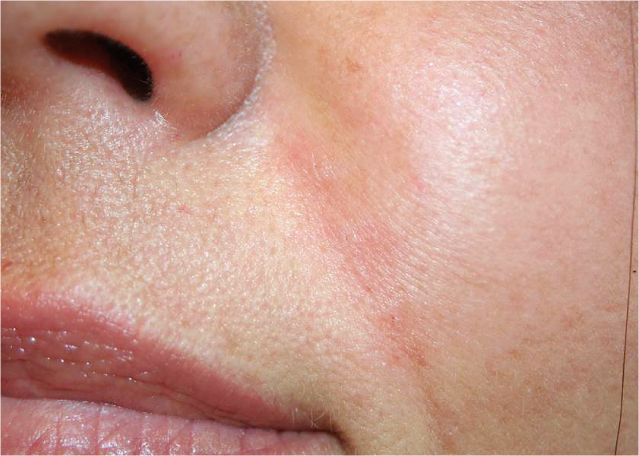
Fig. 1: Overheated swelling during initial injection of the nasolabial fold.
A relatively common side effect that is important to call attention to is a small wheal formation in the sense of urticaria factitia at the injection site. If the patient is an inexperienced practitioner, this can be mistakenly misinterpreted as nodule formation due to too superficial injection with the risk of overcorrection [4, 5]. Other examples of common complications include pain associated with the injection itself and milder alterations caused by the injection itself. This includes mild edema, redness and hematoma formation(Fig. 2) – these complications depend on the treatment site, the selected product and the treatment technique. Especially swelling of the lips after injections is quasi obligatory, frequent in the periorbital area and relatively rare in the nasolabial fold area. The more highly crosslinked the HA is, i.e. the more viscous the gel-like substance, the more frequently the side effects occur. The use of gentle injection techniques can reduce the frequency and extent of such effects, but they can never be completely prevented, even with the greatest care.
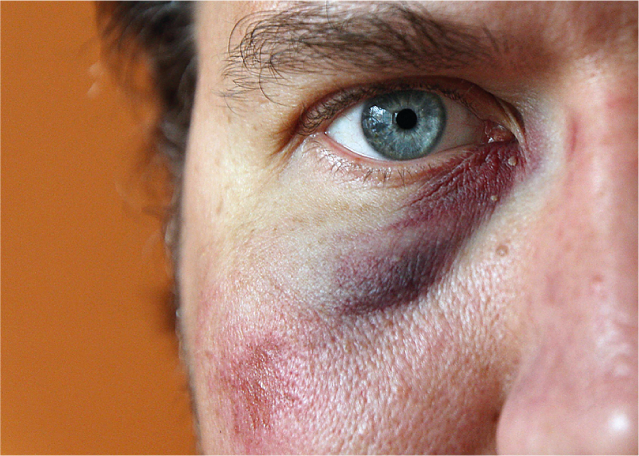
Fig. 2: Suborbital hematoma under the eye
Another very common complication is the visible implant(Fig. 3). The reason for this is always an injection of the HA that has been carried out too superficially. In exceptional cases, the effect can also be caused by the wrong choice of product when highly crosslinked HA is injected intradermally. Here, too, complications can be avoided by correct injection technique and good planning of the procedure with estimation of the feasible and realistic final result.
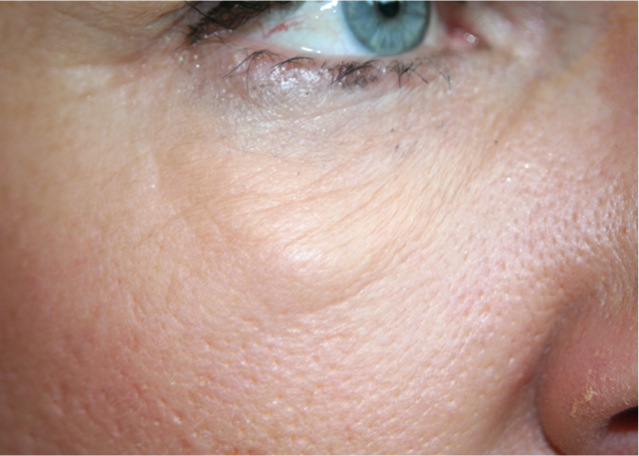
Fig. 3: Pocket formation due to accumulation of filler material in eye area
Rare complications: In general, it can be stated that, in contrast to other procedures, such as botulinum treatments with a delayed onset of action, the definitive result of augmentation treatment is always known after completion of the treatment. Thus, delayed onset of action does not occur during treatment with fillers. If the result after the treatment is successful and as desired, it can be assumed that this result will also last, the volume effect is immediate and no latent development of the effect is to be expected.
Fortunately, infections after HA injections are extremely rare. The treatment procedure is the same as after surgery. Further, necrosis may occur from intra-arterial HA injection, this is a serious complication. It is immediately apparent during the injection itself and frequently occurs during treatments of the glabellar region(Fig. 4) [4], but has also been described as nasal tip necrosis during treatment of the nasolabial folds [5].
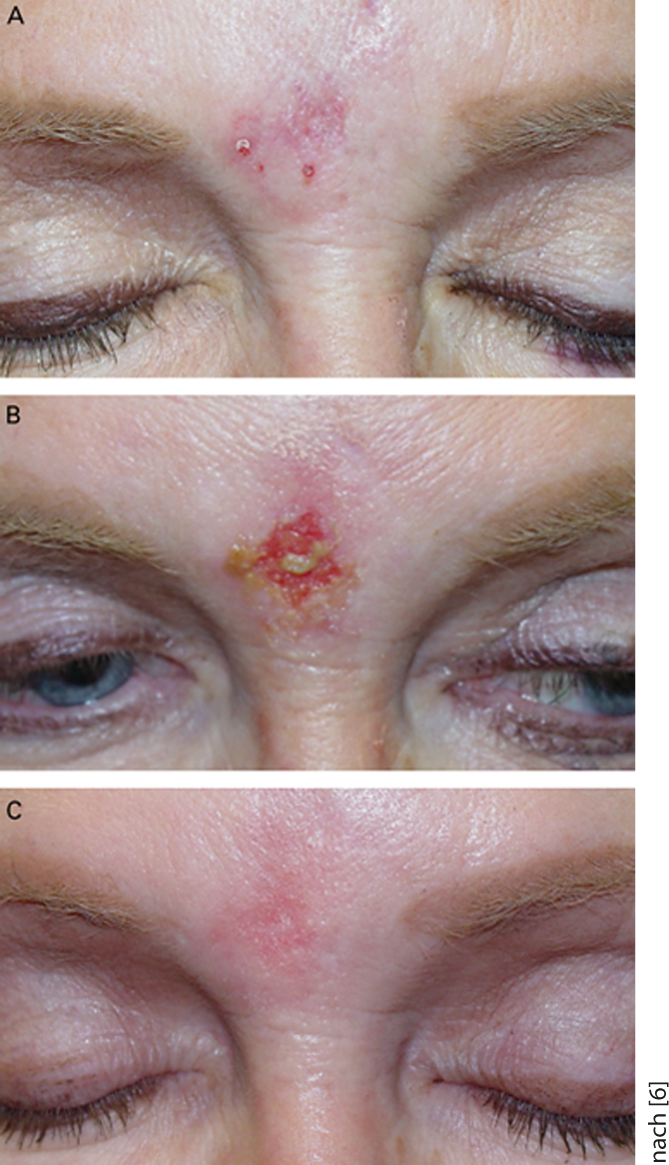
Fig. 4: Necrosis glabella
A typical feature is a discoloration of the injection area (so-called blanching). As an immediate measure, immediate aspiration with the needle still in situ, application of warm compresses is indicated. Further, a 25% nitroglycerin paste must be massaged in and the HA dissolved using hyaluronidase in the same session. A subsequent daily follow-up consultation is important to properly address any wound healing [7].
During treatment with HA, nodules may appear in various forms. The first is the superficial accumulation of filler material. The reason for this is the improper use of the injection technique – the better trained the practitioner is, therefore, the less frequently this complication occurs. The clinically detectable nodules are misinterpreted without biopsy and histologic workup in terms of a product complication and often not due to a technique error. Scientifically correct, one speaks of “nodules” unless there is bioptic evidence of true granulomas(Fig. 5). Furthermore, product-specific nodules should be mentioned as a possible complication, which can be caused by polylactic acid (polylactide-acid sculptra), but also by hydroxyapatide (Radiesse) and occur at depth.
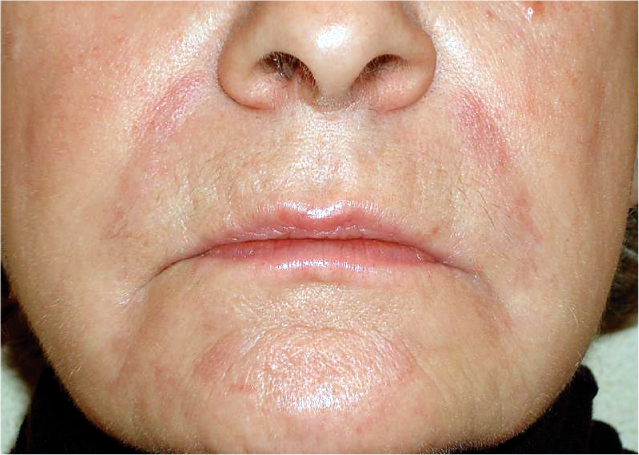
Fig. 5: Only histology confirms the diagnosis of a true granuloma
Also relatively rare are late-onset complications, which usually present as nodules or nodules in the sense of fibrosing foreign body reactions, granulomas, or chronic suppurative infections (biofilms). These are rare and rarely occur in HA implantations. A granuloma (from Latin granulum “granule”) is an inflammation-related, nodular tissue formation of epithelioid cells, mononuclear cells or giant cells. It usually occurs as a reaction to chronic, allergic or infectious processes or even as a foreign body reaction, which is by far the most common when permanent fillers are used. In histology, granulomas can be characterized by their size and histologic structure, which is why a biopsy is mandatory if nodules form.
An extremely rare and controversial complication is the so-called biofilms. These are latent bacterial infections caused by the injection itself. The microorganism colonies protect themselves from the immune system by the pathogens forming an inert surface similar to an encapsulation. Furthermore, biofilms are characterized by the implanted foreign body and adherent colonies which, due to their encapsulation, do not themselves initially have any disease value. However, if trauma occurs again, such as reinjection, biofilms can be reactivated, occasionally resulting in chronic recurrent purulent infection associated with granuloma formation [8]. Due to the encapsulation of the organisms as well as the incubation period, which may last for months, a bioptic bacteriological culture may be negative. In these cases, epifluorescence microscopy is the only means of detection [9].
Complication or acceptable side effect?
Occurring complications are different, depending on the patient and the initial situation of the disease: The sick basalioma patient is cured by a surgical measure and is grateful, even with a possibly unsightly scar. For the aesthetic patient, a harmless short-term adverse reaction (such as swelling or a hematoma) can already mean a serious complication. In terms of aesthetics, therefore, the final result must necessarily be better than the starting point, otherwise it is a complication. In aesthetic dermatology, complications are thus much more frequent than in classical dermatology and the line between success and failure is extremely narrow.
Physician-related complications: The reasons for the occurrence of complications are mostly due to the skills of the physician. Faulty injections are by far the most common cause (pain during injection, hematoma formation, visible implant). These can be avoided by good training and, above all, regular further training of the attending physician. This includes the handling of filling materials, adjustments of injection techniques and the corresponding exchange with colleagues working in esthetics, but also exact anatomical knowledge for the area to be treated and knowledge about the efficiency of the chosen product.
Precise planning and prior determination of the intervention and post-treatment are as much a part of successful treatment as an accurate diagnosis and the decision on how, with which technique, and with which product in which quantity the problem should be addressed. Only those who can present a precisely defined treatment plan in advance are also in a position to fully inform the patient about the result and possible risks. One’s own technical and professional skills must be put to the test: Is the therapist professionally equipped to correct the difficult-to-treat periorbital region with fillers, and are the fillers to be used for this purpose accessible? Furthermore, how to deal with any complications should be planned before the procedure.
Patient-related complications: The patient himself can also be the cause of complications. Many are ambivalent about their first aesthetic procedure – on the one hand, an excessive expectation can often be observed, and on the other hand, a proper basis of trust between doctor and patient has not yet been established. Often the patient expects complete disappearance of the wrinkle without any visible change. This expectation is usually due to ignorance of treatment options and limitations. Expectations should be put into perspective. A profound explanatory discussion with illumination of all shades of the treatment, in particular also the possible undesired side effects, shows competence and creates trust. In addition, it should be explained that minor side effects such as swelling, redness or hematoma formation are possible and by no means equate to a complication.
Product-related complications: The injected product is extremely rarely a cause of complications, as HA has no actual chemical effect but is primarily used physically as a volume substitute. The situation is different with semi-permanent fillers such as polylactic acid. Poly-L-lactic Acid [PLLA]) or calcium hydroxyapatite (CaHyAp). Both substances cause a stimulation of collagen type I after deep injection. Especially PLLA, which is reconstituted in distilled water, has no actual physical volume effect initially. Depending on the preparation of the solution (PLLA), dilution and time of reconstitution as well as the injection technique (PLLA and CaHyAp), nodule formation may increase.
At the beginning of the use of PLLA injections, pronounced nodule formation occurred more frequently than average. Greater dilution of the dry substance (instead of 3 ml, a dilution of 9 ml is now recommended), a longer reconstitution time (dissolution 24 hours before injection), and different injection techniques (deep dermal injections only) can minimize the occurrence of nodules [10].
Conclusion
In aesthetic dermatology, side effects that are accepted as a matter of course in classical dermatology are already considered serious complications. Consequently, in this sub-discipline, even more attention than usual must be paid to an extremely high degree of due diligence. Furthermore, the patient must be informed in advance in detail about all possibilities of an undesirable effect: Information before the procedure is interpreted as clarification, but after the procedure as an excuse.
In principle, complications with HA are relatively rare and, fortunately, when they do occur, they are also relatively harmless, as they are usually short-lived and self-limiting. It is also important to note that many complications can be avoided by having a good knowledge of the products to be injected or of the drug to be administered. can be circumvented by a refined technique. The too frequent complication of the visible implant is a suitable example. Granuloma or foreign body formation occurs mainly with stimulatory fillers, but hardly ever with HA augmentations. However, it must be required here that the present nodules are also bioptically confirmed as granulomas, since frequently filler accumulations are misinterpreted as granulomas or fibrosing foreign body reactions due to improper injection technique – this must be avoided. The main problem with nodule formation is that it can occur with a latency of months to years.
It should be noted, however, that due to the increasing number of treatments performed by different physicians with differences in technique and skills, the risk and number of complications will certainly increase in the future. All the more reason to advocate that aesthetic dermatological procedures belong in the hands of an experienced and highly trained expert.
Literature list at the publisher












